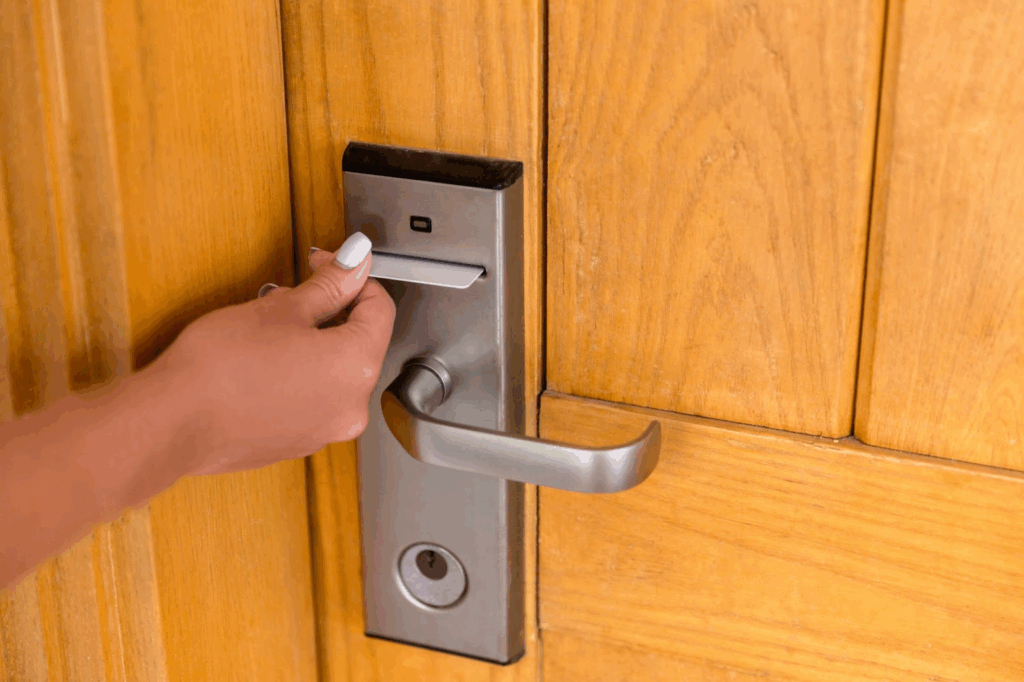Maglocks have become the silent guards of modern buildings. They efficiently secure offices, apartment lobbies, schools, and hospitals. However, like any other device that operates continuously, they require proper care to remain reliable. Failing to maintain them can result in access issues, power glitches, or security lapses. Property managers and security personnel can avoid these headaches with just a bit of consistent attention.
Why Maglocks Need Consistent Maintenance
Electromagnetic locks are durable, but not indestructible. Their long-term function depends on how well they’re maintained, not just how they’re installed. Failing to maintain their upkeep can result in security system failure or downtime. Understanding what stresses them helps prevent expensive problems later.
Mechanical Stress and Daily Use
Each time a door opens or closes, pressure transfers to the maglock. Over time, this stress affects the connection between the magnet and the armature plate. If the door slams frequently, the maglock can shift or loosen from its mounting. These small movements degrade holding force and may cause failures. Always watch for physical movement or vibration when the lock engages.
Environmental Factors That Affect Performance
Dust, humidity, salt air, or extreme heat will impact maglock longevity. Moisture can interfere with the magnetic coil or corrode components. Outdoor units without proper sealing are especially vulnerable. Likewise, internal dust buildup limits surface contact, weakening the bond. Choose weather-rated locks for exposed areas and clean indoor ones regularly.
Power Supply Stability
Maglocks rely on continuous, stable power to remain locked. Voltage drops, surges, or brownouts can weaken their force or damage internal coils. Faulty transformers, battery backups, or power distribution issues can be complex to detect until a lock fails. Use regulated power supplies and surge protection to safeguard your system. Also, test your power sources monthly to confirm consistency.
Daily and Weekly Maglock Maintenance Tasks
Routine checks take minutes but save hours of repairs. They reveal wear and tear before it becomes a problem. Simple testing and observations make your system more dependable. Skipping them risks breakdowns that cost far more time, security, and money.
Test Lock Engagement and Release
Start by verifying that the maglock fully engages when the door closes. Pull the door gently to ensure it resists opening. Trigger the access control system to confirm a clean release. If the lock hesitates, check for delayed power signals or contact misalignment. A clean snap when engaging or releasing is a good sign.
Inspect for Dirt, Debris, or Tampering
Look around the lock for dust buildup, fingerprints, or signs of tampering. Even small particles on the magnet surface can reduce its holding power. Tighten the mounting screws and clear any objects from the gap. Any marks around the lock housing may indicate attempted forced entry. Clean gently with a microfiber cloth and mild cleaner.
Check Access Control Signals and Feedback
Access systems often rely on sensors and relays to signal the maglock. If these signals lag or cut out, the lock may behave unpredictably. Open the access panel to verify that the wiring is intact and undisturbed. LED indicators on control boards often show signal status. If in doubt, use a multimeter to test voltage and continuity.
Monthly Tasks to Keep Your Maglocks Reliable
Monthly upkeep helps catch what daily inspections can’t. These tasks take longer but offer deeper insights into the system’s health. They also help extend the lock’s lifespan and performance. Keep detailed logs for future comparison.
Clean the Armature Plate and Magnet Surface
Even microscopic debris can interfere with the electromagnetic adhesion. Use isopropyl alcohol and a lint-free cloth to wipe both surfaces. Never apply lubricants or oil; they attract dust and weaken the hold. Inspect for pitting, scratches, or rust, and gently buff if necessary. A smooth, clean surface improves performance.

Verify Door Alignment and Closing Force
Improper alignment causes uneven contact between the magnet and the plate. Place a level or straight edge against both components to confirm alignment. If the door closes unevenly, adjust the hinges or mounting brackets to ensure a smooth closure. Also, test the closing force to ensure it doesn’t slam. A soft, controlled closure helps the magnet engage correctly.
Inspect Wiring and Cable Connections
Vibration and time can loosen cable terminals. Look inside junction boxes and access panels for frayed wires, exposed copper, or brittle insulation. Gently tug each wire to ensure it’s firmly seated. Replace cracked cable jackets before they cause shorts. Use cable clamps or ties to prevent future strain.
Seasonal and Annual Maglock Care Tips
The long-term health of your maglocks depends on more than frequent cleaning. Seasonal shifts, aging systems, and changing regulations can all affect reliability. These tasks require more planning but are worth scheduling into your annual maintenance calendar.
Protect Maglocks From Moisture and Weather Changes
Weather changes affect metal, plastic, and electronic components. Over months, expansion and contraction cause misalignment and damage. If your maglocks are located in humid areas, condensation may collect inside the housings. Use desiccant packs or humidity barriers to help. Verify that outdoor enclosures are weather-sealed and free from rust.
Schedule a Professional System Audit
Bring in a licensed locksmith at least once a year. They’ll perform diagnostic tests you can’t do on your own. A professional can recalibrate controls, test voltage under load, and catch failing parts. That procedure also helps with compliance if your building follows fire or security regulations. Ask for a written report after the audit.
Update Firmware or Software in Integrated Systems
If your maglocks connect to an intelligent access control system, keep it updated. New firmware can fix bugs, improve performance, or close security gaps. Log in to your admin panel to check for update notifications. Schedule downtime during off-hours to avoid user disruption. Always back up settings before updating.

Common Maglock Issues and Quick Fixes
When maglocks stop working, they rarely fail without warning. Minor symptoms often appear first, and spotting them early helps fix them quickly. The following are the most common issues to watch for, along with the steps to identify and address them before they worsen.
Lock Fails to Hold or Release
If a maglock doesn’t hold, check for misalignment or dirt first. If it doesn’t release, inspect the power signal or button wiring. Failing relays or dead batteries in backup systems may cause issues. Also, test the magnet’s coil for resistance using a multimeter. Replace the coil if readings fall outside the manufacturer’s range.
Door Doesn’t Close Flush
A door that doesn’t sit flat against the frame prevents the magnet from holding fully. Check the hinges, frame, and strike plate for gaps. Tighten loose hardware and adjust as needed. Consider using a door closer for smoother operation; a flush close guarantees complete contact between parts.
Maglock Hums or Overheats
Some humming is normal, but loud buzzing signals a problem. It could be caused by coil damage, voltage mismatch, or mounting vibration. Overheating may indicate a failing coil or improper duty cycle. Use thermal sensors or touch the housing to test the temperature. Replace the unit if it runs hot for long periods.
When to Replace or Upgrade Your Maglock System
All hardware has a shelf life, and maglocks are no exception. Knowing when repairs are no longer effective is part of responsible management. The following signs indicate it’s time to move on.
Signs of Wear That Can’t Be Fixed
If the magnet surface is deeply pitted or warped, replacement is better than repair. Fractured housings, stripped mounting threads, or rattling parts are red flags. Repeated malfunctions after cleaning or alignment are another warning. Old locks often fail under peak load, not during tests. Don’t gamble with outdated parts.
Outdated Tech and Compatibility Problems
If your lock system struggles to integrate with newer access control software, it may be outdated. Modern systems offer features such as remote diagnostics, logs, and alerts; however, maintaining outdated hardware limits the benefits of these features. Upgrades may include cloud support, wireless controls, or innovative credential options. Compatibility saves time and reduces admin errors.
Increased Security Needs or Usage Changes
If your building now experiences increased foot traffic or handles sensitive materials, your old maglock setup may not be sufficient. Higher-strength locks or multiple-entry configurations might be necessary. A system designed for light office use won’t scale well to a hospital wing or data center. Upgrade proactively when your needs grow.
Smart Habits That Extend the Life of Your Maglocks
Good habits are just as important as scheduled checkups. The small things you do day to day matter. Building a system around awareness and response yields long-term benefits. These habits keep your locks working without fail.
Log Maintenance and Test Results
Record each inspection, test, or repair in a digital log. Please include dates, issues found, and how they were fixed. Logs help track wear patterns and predict when replacements are needed. They also help with compliance and warranty claims. Share them with staff or vendors when problems arise.
Train Staff to Report Maglock Irregularities
Staff who use the doors daily are your best sensors. Train them to report issues such as rattling doors, buzzing locks, or access delays. Make it easy to report problems by using QR codes or a shared inbox. Early alerts mean fewer surprises. Encourage regular feedback, not just emergency calls.
Use Surge Protection and Clean Power Supply
Clean, consistent power keeps electronics stable and safe. Install surge protectors between the maglock system and its power source. Check battery backups monthly and replace aging units. Keep wiring tidy and off the floor. Dirty power causes long-term damage that’s hard to trace.
Keep Your Maglocks Safe and Reliable
Maglocks only protect you if they work when it counts. A simple failure can block entry or let in the wrong person. That risk grows each day you delay maintenance. Every skipped inspection, loose screw, or dusty surface builds toward a breakdown. Take control of your system now; your building depends on it.
Keep your maglocks strong, your building safer, and your team informed. Explore more insights now on the Green Key blog.



